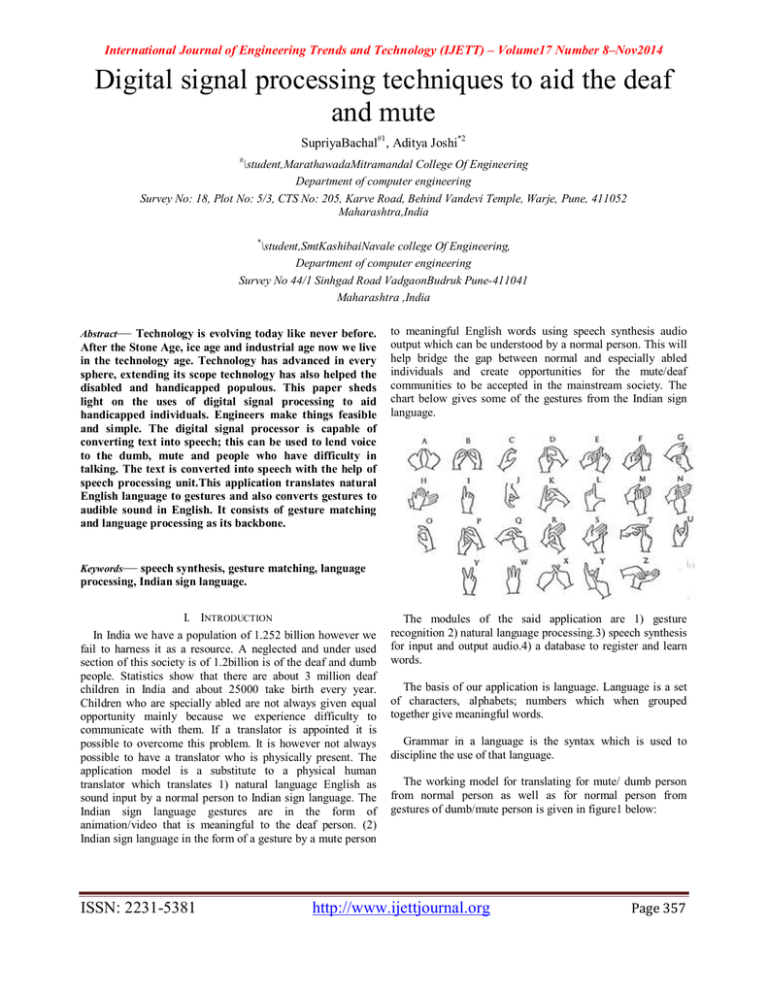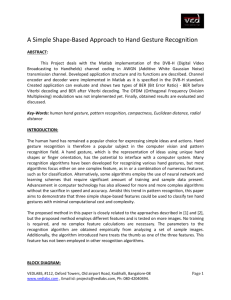Digital signal processing techniques to aid the deaf and mute SupriyaBachal
advertisement

International Journal of Engineering Trends and Technology (IJETT) – Volume17 Number 8–Nov2014 Digital signal processing techniques to aid the deaf and mute SupriyaBachal#1, Aditya Joshi*2 # \student,MarathawadaMitramandal College Of Engineering Department of computer engineering Survey No: 18, Plot No: 5/3, CTS No: 205, Karve Road, Behind Vandevi Temple, Warje, Pune, 411052 Maharashtra,India * \student,SmtKashibaiNavale college Of Engineering, Department of computer engineering Survey No 44/1 Sinhgad Road VadgaonBudruk Pune-411041 Maharashtra ,India Abstract— Technology is evolving today like never before. After the Stone Age, ice age and industrial age now we live in the technology age. Technology has advanced in every sphere, extending its scope technology has also helped the disabled and handicapped populous. This paper sheds light on the uses of digital signal processing to aid handicapped individuals. Engineers make things feasible and simple. The digital signal processor is capable of converting text into speech; this can be used to lend voice to the dumb, mute and people who have difficulty in talking. The text is converted into speech with the help of speech processing unit.This application translates natural English language to gestures and also converts gestures to audible sound in English. It consists of gesture matching and language processing as its backbone. to meaningful English words using speech synthesis audio output which can be understood by a normal person. This will help bridge the gap between normal and especially abled individuals and create opportunities for the mute/deaf communities to be accepted in the mainstream society. The chart below gives some of the gestures from the Indian sign language. Keywords— speech synthesis, gesture matching, language processing, Indian sign language. I. INTRODUCTION In India we have a population of 1.252 billion however we fail to harness it as a resource. A neglected and under used section of this society is of 1.2billion is of the deaf and dumb people. Statistics show that there are about 3 million deaf children in India and about 25000 take birth every year. Children who are specially abled are not always given equal opportunity mainly because we experience difficulty to communicate with them. If a translator is appointed it is possible to overcome this problem. It is however not always possible to have a translator who is physically present. The application model is a substitute to a physical human translator which translates 1) natural language English as sound input by a normal person to Indian sign language. The Indian sign language gestures are in the form of animation/video that is meaningful to the deaf person. (2) Indian sign language in the form of a gesture by a mute person ISSN: 2231-5381 The modules of the said application are 1) gesture recognition 2) natural language processing.3) speech synthesis for input and output audio.4) a database to register and learn words. The basis of our application is language. Language is a set of characters, alphabets; numbers which when grouped together give meaningful words. Grammar in a language is the syntax which is used to discipline the use of that language. The working model for translating for mute/ dumb person from normal person as well as for normal person from gestures of dumb/mute person is given in figure1 below: http://www.ijettjournal.org Page 357 International Journal of Engineering Trends and Technology (IJETT) – Volume17 Number 8–Nov2014 HAND GESTURES II. GESTURE RECOGNITION, FETCHING CORRESPONDING SIGN MEANINGTEXT TO SPEECH,SPEECH TO TEXT . The first step at this end is the input of gestures by the signer. This gesture is given as input in the 32-bit blob depth image format. An Intel depth camera is used at this end to get input. The input is further processed by Intel perceptual computing SDK. The process extracts the coordinates of the hand movements, in three planes X, Y and Z. Most of the hand movements are dynamic and hence we require 3D processing, if we encounter a static hand gesture only X and Y coordinates are noted and used. The coordinates are used to simulate the pose and gesture from the fingers to the hands. In the next step the actual translation takes place from Indian sign language to English. In this step an NLP engine is used along with the learned rules and database of stored words.fig2 illustrates the process. NATURAL SPEECH hand gesture Fig1 The major challenge to implement this model is that there are around 2000+ gestures standardized by the Indian sign language community and most of these gestures are dynamic. The English language has 26 letters and 10 numbers, the implementations of these are in static form as shown above however there are many gestures which are in dynamic form such as park, bench, him, her etc. To add to this complex sentences have a very complicated format. Segmentation of the complex sentence and converting them into Indian sign language is a herculean task .A variety of verbs have the same gesture for its present past and future tense thus it becomes difficult to convey the tense of a sentence. Database management is a another major issue as mentioned earlier there are 2000+ gestures that are accepted by the Indian sign language community, However there are synonyms to some gestures. It is very difficult and time consuming to get the synonyms for every gesture to avoid the situation such that for two words having the same meaning there is a gesture for one word in the database but the other word has no gesture in the same database. LITERATURE SURVEY: Many methods are used to research on sign language. The signer is meant to wear gloves to assist the process of isolating the hands of a signer using colorsegmentation, many other devices are used to recognize the hand gestures however these methods are not advisable as they have their own drawbacks. These devices hamper the naturalness of the sign language, to add to it these devices are not very cost effective. This application will try to read sign language without the use of his device. A comparatively inexpensive depth gesture recognition camera is used along with innovative software WORKING: This application has two end users 1) deaf and mute end 2) normal user end. Deaf and mute user end: ISSN: 2231-5381 gesture template matching fetch corresponding meaning text to speech conversion natural voice output/text output Fig 2 From normal user to deaf/mute user: This is the other end of the application where the English sentences have to be converted to sign language. The first step in this process is voice recognition. To initiate this process the primary step is to record the voice. The second step is to send this recorded voice to Google voice recognition system, which provides the voice in text form after processing it. In the third and last step the text is to be converted into a video or an animation. In the last step the database is used to fetch the corresponding gestures to the text. Machine learning is used to learn the natural language and gesture recognition. Fig3 illustrates the process http://www.ijettjournal.org Page 358 International Journal of Engineering Trends and Technology (IJETT) – Volume17 Number 8–Nov2014 Natural language module: English language is used as a natural language. Natural language processing is the basis of this application and it is also the most challenging module which is required to be Performed. natural voice voice recognition . get the sentence Gesture database fetch sign for important words Creating & matching template using threshold show output gestures Training Fig3 Building template 1) Voice synthesis and recognition module: Its main responsibility is to convert from voice input to text output. The voice synthesis is carried out by Intel perceptual SDK voice synthesis module. On the other hand the voice recognition is used to convert from voice to text. The processing of natural language is done using Google API.Google API is most efficient for most accents. It recognizes Indian accents and hence is apt for this application. 2) Gesture recognition module: The movements of the hand are tracked on the X, Y and Z plane. Each movement or a static instance gives a set of hand and fingers features. Track of the dynamic movement and instances of the static gestures. The movements will be such as moving the left hand in the right direction and thumbs up. Combination of these sets of movements makes a meaningful ISL word. And sets of such meaningful words create a meaningful ISL sentence. The movement of the hand and fingers is tracked and it matches with any earlier occurrence it then results in an identified gesture. It does a self-learning and training which results in improved efficiency at later stages. If a gesture returns an inappropriate output it accepts the corrected result from the user and improves its effectiveness. ISSN: 2231-5381 Track hand and finger movement s (left, right, down, up etc.) Fig 4 Conclusion: The paper stated the development of an interpreter for communication between a normal and an especially abled person. Technical aspects of the paper include heavy processing of gestures and sentences over a network to achieve a realistic model. The components namely Natural language processing responsible for translation of English to sign language and vice versa. In totality this application helps bridge the gap between normal and specially abled individuals, providing the specially abled more opportunities for betterment. References: [1] RostislavMiarka and Martin Žáček “Knowledge patterns in RDF graph language for English sentences” in Proceedings of the Federated Conference on Computer Science and Information Systems pp. 109–115 ISBN 978-83-60810-48-4 [2] UMESH CHANDRA JAISWAL, DR. RAVINDRA KUMAR and DR SUSHIL CHANDRA “A Structure Based Computer Grammar to Understand Compound-Complex, Multiple Compound and Multiple-Complex English Sentences in 2009 http://www.ijettjournal.org Page 359 International Journal of Engineering Trends and Technology (IJETT) – Volume17 Number 8–Nov2014 International Conference on Advances in Computing, Control, and Telecommunication Technologies [3] XiaohuiShen, Gang Hua, Lance Williams and Ying Wu“Motion Divergence Fields for Dynamic Hand Gesture Recognition” [4] T.F. Michael Raj, Durga Shankar Baggam, M. Prabhu and H.Manikandan “A Domain Based Approach for the Animated Cum Automated Modelfor Deaf and Dumb Using NLP” in Research Journal of Applied Sciences, e-ISSN: 2040-7467 [5] Rada Mihalcea1, Hugo Liu2, and Henry Lieberman2 “NLP(Natural Language Processing) for NLP (Natural Language [6] J. Ignacio Serrano and Lourdes Araujo “Evolutionary Algorithm for Noun Phrase Detection in Natural Language Processing” in TIC2003-09481-C04 and FIT150500-2003373.s [7] PoonamSuryanarayan and Anbumani Subramanian, Dinesh Mandalapu “Dynamic Hand Pose Recognition using Depth Data” in 2010 International Conference on Pattern Recognition [8] A. M. Turing “COMPUTING MACHINERY AND INTELLIGENCE” in A. M. Turing (1950) Computing Machinery and Intelligence. Mind 49: 433-460. [9] Md. Abu NuserMusud’, Md. MuntusirMamunJoarder’, Md.Turiq-UI-Azam “A general approach to natural language coercion. ISSN: 2231-5381 http://www.ijettjournal.org Page 360





